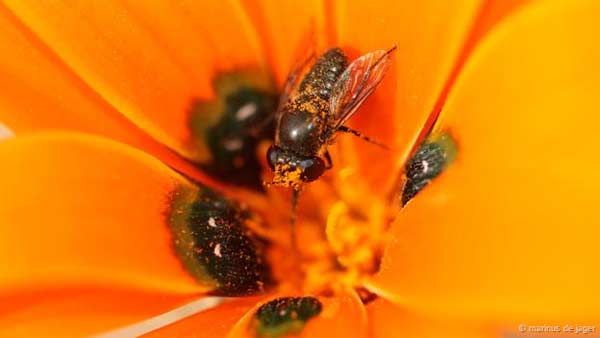
Western Cape, South Africa (BBN)-The best bouquets are often a riot of colour and shapes, and the flowers above would make a beautifully varied bunch, replete with petals of notched yellow, rounded red, or jagged peach with centres of yellow, orange, green or black.
But incredibly, these flowers are all the same flower, belonging to the single South African daisy species Gorteria diffusa, reports BBC.
Even more incredible is that the same flower comes in 11 more distinct forms, making it perhaps the most varied flower on earth.
So how can a single flower appear in 14 different guises?
The truth is we don’t yet know, not exactly.
But research suggests this single mysterious daisy is at the centre of an evolutionary struggle involving some tiny bee flies, sex and the art of deception.
And this struggle has created the astonishing variety of forms we see today in this single species.
Flowering plants create blooms to attract pollinators, mostly small insects that carry pollen away, allowing the plants to reproduce.
Plant breeders can of course artifically create varieties of one type of flower.
But in the wild, its the arrival of new pollinators that can drive the evolution of floral designs.
Flowers that appear different may attract new pollinators, and produce more offspring.
That creates a selection pressure for flowers to evolve new colours and shapes, and can lead to one flower species eventually splitting into two new species.
But this multi-coloured daisy doesn’t fit this pattern at all. That’s because all 14 forms of the flower are pollinated by the same insect, the small bee fly Megapalpus capensis.
Something else is going on; and there is a clue in the flower’s structure.
Although it can present in 14 distinct forms, there are actually just three basic or ‘functional’ types of this South African daisy.
The first is called the ‘feeding form’. These daises provide nectar and pollen, and their petals are quite plain, of a single colour.
On the feeding form it's just a flat, pigmented surface. There is no three dimensionality,” explains Dr Marinus de Jager, a postdoctoral researcher at Stellenbosch University in South Africa.
Male and female bee flies simply feed from these flowers.
A second type is called the ‘inspection form’. These flowers also provide nectar and pollen for male and female bee flies. But they do something else too.
The flower also produces spots on its petals that mimic female bee flies. These attract the attention of male bee flies.
They’ll just quickly land on one of these small black spots and then take off again,” says de Jager.
But the flies aren’t so fooled by the spots that they try to mate them. “It’s not full blown mating behaviour,” confirms de Jager.
The third type of daisy is the most deceptive.
It also has spots, but they do not appear on every petal. That better replicates the natural, random pattern that would be formed by the temporary landing of one or more female flies.
The spots are also more complex, being three dimensional and raised off the surface, including ridges, adaptations that make them appear more like a real bee fly.
The presence of these spots is itself remarkable; until recently, orchids were the only plant group thought to often use sexual mimicry to deceive and attract pollinators.
These complex spots have long intrigued botanists, who first suggested they mimicked beetles, leading to the daisy’s common name still used today the beetle daisy.
In 1997, botanists examined these spots using a scanning electron microscope.
They found the spots reflect ultraviolet light (UV), in the same way as a bee fly’s body does.
They also found that cells around the centre of each spot have light-reflecting tips, making the spot appear to sparkle in the sunlight.
But were these spots really attracting the bee flies? The botanists did an experiment to find out.
They removed spotted versus unspotted petals from flowers, and then gave the bee flies a choice. The result: fewer spots meant fewer visits.
That suggests the males are sexually attracted to these spots, and by trying to mate with them, increasing the chances they will pollinate the flower.
More recently, de jager and collaborator Dr Allan Ellis at the University of Stellenbosch investigated whether the sexual preferences of the flies might be might be driving the evolution of so many different varieties of beetle daisy.
They designed experiments giving male and females a series of binary choices between different spot patterns, to see what they liked.
Females, they learned, prefer simple spots, and avoid UV highlights.
Males, in contrast, prefer textured, glossy, visually complex, UV highlighted spots.
Their experiments hint that the evolution of the sexually deceptive, fly-faking forms of the daisy may be driven entirely by the preferences of male bee fly males.
Yet visual signals are not the only messages the flowers are sending out. Floral odour also seems to be another lure.
But in contrast to what’s seen in orchids, it's the female bee fly that finds this perfume attractive, suggesting we do not yet fully understand what has driven the remarkable variation in this single flower species.
Leaving us with a complex, enigmatic and beautiful flower, and some remaining questions about how it came to be.
BBN/ZI/AD